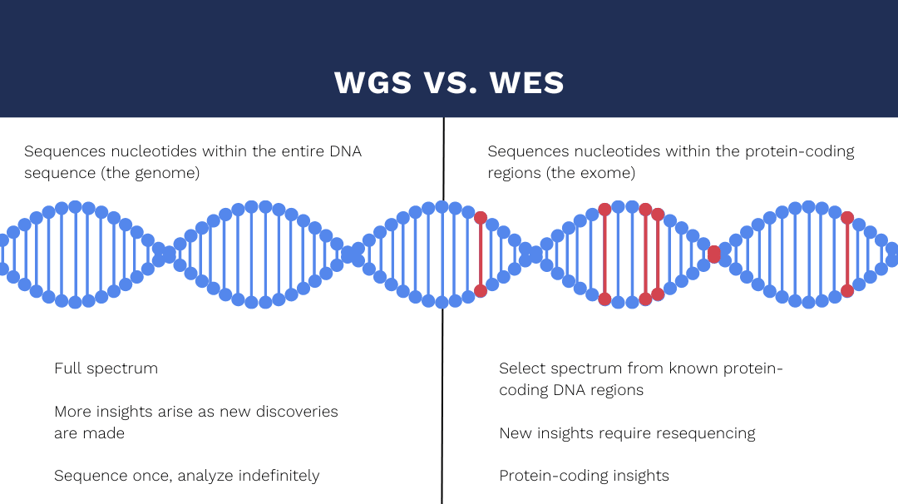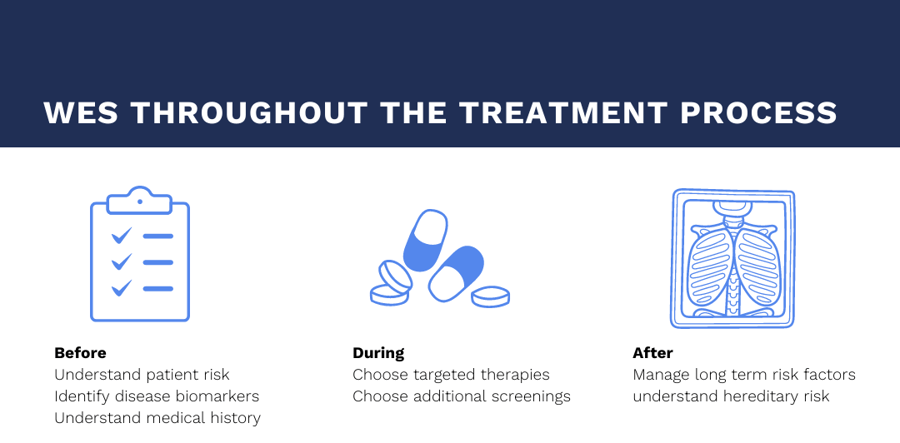Considering implementing whole exome sequencing (WES) in your clinical practice? This article goes over the must-know information you need to get started, as well as resources to understand how to use clinical WES to its full potential.
In This Article
- What Is the Exome?
- What Is Whole Exome Sequencing?
- How Does Whole Exome Sequencing Work?
- What Is the Difference Between Whole Exome Sequencing and Whole Genome Sequencing?
- Why Would My Patient Need Whole Exome Sequencing?
- Why Should I Use Whole Exome Sequencing?
- What Can Whole Exome Sequencing Detect?
- What Are the Benefits of Whole Exome Sequencing?
- What Is Whole Exome Sequencing Trio Analysis?
- Will My Exome Report Impact My Patient’s Insurance Rates?
- Is Whole Exome Sequencing Covered by Health Insurance?
- Why Should I Use Psomagen for Whole Exome Sequencing?
1. What Is the Exome?
The exome is made up of sections of the genome called exons. Exons are transcribed into mRNA and then translated to proteins. Most disease-causing genetic variants occur in these exonic regions.
Exons get their name from the phrase “expressed region,” because they are the part of the genome that codes proteins. The rest of the genome (the “intragenic region”) does not appear in the final protein.
Even though the exome only makes up around 2% of the entire genome, it contains about 85% of identified disease-causing genetic variants. Targeting the exome is a good option for patient care and personalized medicine. WES provides insight into clinically relevant genetic variations that affect how proteins are coded.
2. What Is Whole Exome Sequencing?
WES is a next-generation sequencing technology in which exons are sequenced and analyzed for specific mutations. When a patient's exome contains certain mutations, you can better understand how to treat the patient.
3. How Does Whole Exome Sequencing Work?
You would first order a sample of DNA, blood, or saliva from a patient or family member. These samples are then sent to a laboratory to initiate whole exome sequencing. By analyzing the exome, abnormalities and indicators of disease are identified.
4. What Is the Difference Between Whole Exome Sequencing and Whole Genome Sequencing?
While both whole exome sequencing and whole genome sequencing are used in personalized medicine, there are key differences. Whole genome sequencing analyzes the entire genome, while WES analyzes just the exome regions of the genome.
The processes are also different. Whole exome sequencing uses a capture-based methodology focusing on coding regions and sequences the exome. Whole genome sequencing does not necessitate a capture-based process while doing sequencing and offers a broader approach to personalized medicine.
Each technology is valuable in different clinical circumstances. Whole genome sequencing is used for novel discoveries. It is most helpful to identify biomarkers and potential therapeutic targets for diseases.
In comparison, WES is useful when you have an idea of the patient’s condition and where its genetic indicators can be found in the exome. When there are abnormal sequences within the genome or exome, you can use those findings to detect, diagnose, and treat the patient.
5. Why Would My Patient Need Whole Exome Sequencing?
Whole exome sequencing is beneficial for patients:
- Who are suspected to have a genetic or hereditary disorder
- Who have had inconclusive test results
- Whose test results are not consistent with the expected condition
- Who need to monitor their disease’s progression or severity
6. Why Should I Use Whole Exome Sequencing?
WES might be the right choice if you are interested in:
- Understanding a patient’s risk of genetic disease. If a patient has biomarkers associated with a genetic condition, you can use that information to better understand their symptoms. When a patient’s exome is sequenced, it is analyzed using a reference genome to identify genetic mutations. From there, you can identify incomplete, atypical, or anomalous genes.
- Gaining rare disease insights. If a patient has a rare condition, identifying disease biomarkers can help you choose more targeted therapeutic interventions. Although whole genome sequencing is able to pick up on biomarkers throughout the genome, WES is sometimes used as a likely place to start.
- Gaining hereditary disease insights. If a patient’s family members are sequenced, you can provide insights into hereditary conditions. It can help make informed decisions for a patient or family member’s care.
- Understanding a patient’s medical history. A patient’s genetic information helps put their medical history into context. By combining WES genomic data and medical history information, you can better understand a patient’s disease progression.
- Choosing next steps for treatment. WES can point toward the next logical screening or procedure for a patient's medical care. It is a way to fast-track a patient toward wellness, without wasting time with misdiagnoses or less effective treatment options.
7. What Can Whole Exome Sequencing Detect?
Whole exome sequencing can detect:
- Changes within the genetic code
- Cancers
- Hereditary diseases
- Genetic and rare diseases
- Genetic abnormalities and mutations
WES acts as a solution for problems with detection and diagnosis. Upon completion of the analysis, you can go over the results and treatment options with your patients.
8. What Are the Benefits of Whole Exome Sequencing?
Whole exome sequencing offers a smaller data set than whole genome sequencing. This makes it easier and faster to medically manage patients. By focusing on the genes most likely to cause disease, you can offer targeted, personalized care.
Whole exome sequencing is also more affordable than whole genome sequencing because of its smaller data set. For decades, researchers have worked toward bringing the cost of whole genome sequencing below $1,000 per genome. WES, by comparison, typically starts at around $400. This makes it a much more accessible option for patients.
Whole exome sequencing helps make safe decisions for patient and family health. You and your patients save money, time, and effort.
Conditions that previously sent patients on a diagnostic odyssey of years can now be diagnosed in a matter of months. A recent study published in Genetics in Medicine analyzed the exome of 115 patients, most of whom had birth defects, developmental delay, or repeated seizures. WES allowed 100% of patients to discontinue additional testing. Among other benefits, 32.2% received definitive diagnoses, 12.2% changed their plan of care, and 1.7% began novel therapies.
9. What is Whole Exome Sequencing Trio Analysis?
Whole exome sequencing can be used for trio analysis. WES trio analysis involves testing the DNA of a patient and their biological parents to identify genetic alterations that are passed down to offspring. This type of whole exome sequencing distinguishes inheritance patterns and risks of recurrence, allowing for personalized medicine and targeted patient care.
What does that look like in practice? In a study from Zhengzhou Children’s Hospital, 54 children with neurodevelopmental disorders underwent trio WES analysis paired with CNV-Seq. The technology helped clinicians categorize patients as having autosomal dominant disorders, autosomal recessive disorders, X-linked dominant or recessive disorders, and mutated genes.
In this study, a three-month-old infant was admitted to the hospital for repeated seizures. Trio WES showed that the child and the father both had a genetic indicator for oxidative phosphorylation deficiency 6. COXPD6 is a disorder that leads to cell death in tissues that demand a lot of energy.
10. Will My Exome Report Affect My Patient's Insurance Rates?
Whole exome sequencing will not affect the insurance rates of patients. The Genetic Information Nondiscrimination Act (GINA) prevents insurance companies from denying coverage based on genetic test results. GINA also protects patients from employer discrimination. Life and long-term care insurance have different policies, but a patient’s medical insurance will not be affected by whole exome sequencing analysis.
11. Is Whole Exome Sequencing Covered by Health Insurance?
Many health insurance plans do not cover whole exome sequencing because it is not considered a “medical necessity.” However, some insurers may cover it at their discretion. Patients will have to talk with their insurance provider to see if whole exome sequencing is covered. If not, paying for WES would have to come out of pocket.
In the earlier Genetics in Medicine study, for example, only 1 of 115 participants used self-pay.
12. Why Should I Use Psomagen for Whole Exome Sequencing?
Psomagen is one of the industry's leading providers of genomic services and sequencing. Psomagen laboratories are CLIA-certified and CAP-accredited. This ensures that the WES workflow and equipment are securely controlled from sample receipt to release of data. All lab personnel are frequently reevaluated based on federal guidelines, and only authorized personnel can access patient data.
De-identified samples and sequencing data are also stored for two years in case further sequencing or analysis is required in the future.
Psomagen offers a complete solution for variant discovery using whole exome sequencing. Whole exome sequencing is paving the way toward understanding genetics in human disease, with more and more clinical applications implemented every day. Call today to partner with Psomagen for your medical diagnostic needs.



